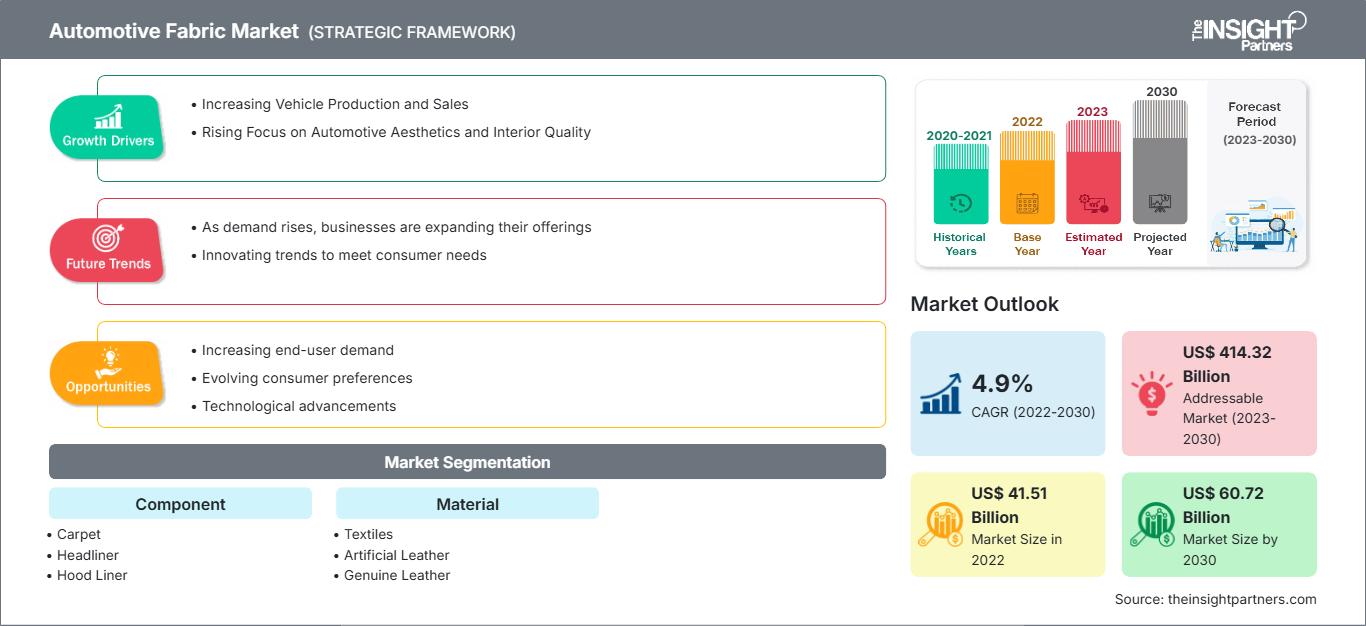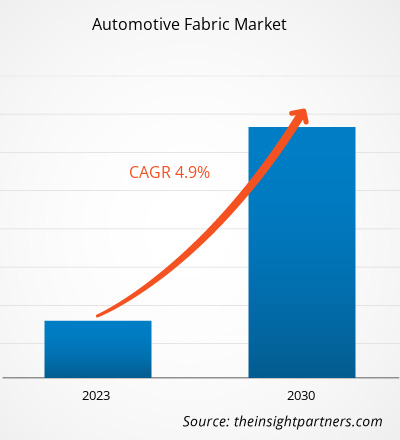[Forschungsbericht] Der Markt für Automobiltextilien hatte im Jahr 2022 ein Volumen von 41.513,83 Millionen US-Dollar und soll bis 2030 voraussichtlich 60.722,34 Millionen US-Dollar erreichen; von 2022 bis 2030 wird eine durchschnittliche jährliche Wachstumsrate (CAGR) von 4,9 % erwartet.
MARKTANALYSE
Automobiltextilien sind gewebt, als Vlies oder beschichtet erhältlich. Diese Stoffmaterialien sind sehr flexibel und zeichnen sich durch Eigenschaften wie UV- und Kälterissbeständigkeit sowie Langlebigkeit und geringes Gewicht aus. Automobiltextilien bieten Sitzkomfort und verbessern das ästhetische Gesamterlebnis. Das Marktwachstum wird stark durch technologische Fortschritte sowie die Vorliebe für höchsten Komfort und hochwertige Materialien vorangetrieben. Mit der steigenden Automobilproduktion ist auch die Nachfrage nach Autozubehör gestiegen, was in den kommenden Jahren voraussichtlich zum Wachstum des Marktes für Autotextilien beitragen wird.
WACHSTUMSTREIBER UND HERAUSFORDERUNGEN
Die Weiterentwicklung der Automobilproduktionskapazitäten und die steigende Nachfrage nach Elektrofahrzeugen sind einige Faktoren, die das Wachstum der globalen Automobilindustrie ankurbeln. Die Automobilindustrie ist eine der führenden Branchen in Europa, da sie erheblich zum BIP europäischer Länder wie Deutschland, Italien und Großbritannien beiträgt. Der Fokus auf die Entwicklung der Ästhetik und Eigenschaften von Innen- und Außenbereichen von Autos hat zugenommen, da die Verbraucher Wert auf Qualität und Ästhetik legen, was die Nachfrage nach Autotextilien antreibt. Regierungen verschiedener Länder haben strenge Sicherheitsvorschriften erlassen, darunter die obligatorische Installation und Verwendung von Sicherheitsgurten, Airbags und Antiblockiersystemen, um die Sicherheit im Fahrzeug zu verbessern, was die Nachfrage nach leistungsstarken und sicheren Autotextilien steigert. Die steigende Fahrzeugproduktion und der zunehmende Fokus auf die Ästhetik im Automobilbereich treiben das Wachstum des Marktes für Autotextilien voran.
Polyvinylchlorid (PVC) und Polyurethan (PU) sind zwei der am häufigsten verwendeten synthetischen Kunststoffpolymere zur Herstellung von Kunstleder. Die Herstellung von Kunstleder aus Kunststoff ist nicht umweltfreundlich. Der Produktionsprozess der in den meisten Kunstledern verwendeten Kunststoffe ist oft relativ energieintensiv und chemikalienreich und produziert zudem erhebliche Mengen Abfall. Daher hemmen die schädlichen Auswirkungen von PVC und PU sowie die geringere Haltbarkeit von Kunstleder im Vergleich zu Leder das Wachstum des Marktes für Autotextilien.
Passen Sie diesen Bericht Ihren Anforderungen an
Sie erhalten kostenlos Anpassungen an jedem Bericht, einschließlich Teilen dieses Berichts oder einer Analyse auf Länderebene, eines Excel-Datenpakets sowie tolle Angebote und Rabatte für Start-ups und Universitäten.
Markt für Automobilstoffe: Strategische Einblicke

-
Holen Sie sich die wichtigsten Markttrends aus diesem Bericht.Dieses KOSTENLOSE Beispiel umfasst Datenanalysen, die von Markttrends bis hin zu Schätzungen und Prognosen reichen.
SEGMENTIERUNG UND UMFANG DES BERICHTS
Die „Globale Marktanalyse und Prognose für Automobilstoffe bis 2030“ ist eine spezialisierte und detaillierte Studie mit einem starken Fokus auf globale Markttrends und Wachstumschancen. Der Bericht bietet einen Überblick über den globalen Markt mit detaillierter Marktsegmentierung nach Komponenten, Materialien und Geografie. Er liefert wichtige Statistiken zum weltweiten Verbrauch von Automobilstoffen sowie deren Nachfrage in wichtigen Regionen und Ländern. Darüber hinaus bietet der Bericht eine qualitative Bewertung verschiedener Faktoren, die die Marktentwicklung für Automobilstoffe in wichtigen Regionen und Ländern beeinflussen. Er enthält außerdem eine umfassende Analyse der führenden Akteure auf dem Markt für Automobilstoffe und ihrer wichtigsten strategischen Entwicklungen. Eine Analyse der Marktdynamik ist ebenfalls enthalten, um die wichtigsten Antriebsfaktoren, Markttrends und lukrativen Gelegenheiten zu identifizieren, die wiederum bei der Identifizierung der wichtigsten Einnahmequellen helfen.
Die Ökosystemanalyse und Porters Fünf-Kräfte-Analyse bieten eine 360-Grad-Ansicht des globalen Marktes für Autotextilien, die hilft, die gesamte Lieferkette und die verschiedenen Faktoren zu verstehen, die das Marktwachstum beeinflussen.
SEGMENTANALYSE
Der globale Markt für Autotextilien ist nach Komponenten und Materialien unterteilt. Basierend auf den Komponenten ist der Markt für Autotextilien in Teppiche, Dachhimmel, Motorhaubenverkleidungen, Isolierungen, Sitzbezugsmaterialien und Sonstiges segmentiert. Basierend auf den Materialien ist der Markt in Textilien, Kunstleder, echtes Leder und Kunstwildleder segmentiert. Darüber hinaus machte das Teppichsegment im Jahr 2022 einen erheblichen Anteil des Marktes für Autotextilien aus. Stoffe für Teppiche werden ausschließlich aus Nadelvlies, Vlies oder getuftetem Gewebe hergestellt. Polyester, Polyamid, Polypropylen und Aramid werden bevorzugt als Fasermaterialien für Teppiche zur Verschönerung von Fahrzeuginnenräumen verwendet. Dachhimmel bestehen aus Trikot-Strickgewebe, das sich weich anfühlt, einheitlich wirkt und zum Gesamtdesign des Innenraums beiträgt. Ein Motorhaubenhimmel besteht aus einer dünnen Schicht Isoliermaterial mit einem speziellen Schallschutzelement, das Motorgeräusche aufgrund einer fehlerhaften Motorhaubenisolierung verhindert. Akustische und thermische Isolierung gilt als eines der wichtigsten Merkmale verschiedener Fahrzeugteile wie Motorabdeckungen, Unterbodenabdeckungen, Motorhauben und anderen Fahrzeugteilen. Trilaminat-Polyester wird als Bezugsstoff für viele Arten von Autositzen verwendet.
Materialbezogen hatte das Textilsegment im Jahr 2022 einen bedeutenden Anteil. Automobiltextilien finden vielfältige Anwendung in Autos, Zügen, Bussen und anderen Fahrzeugen. Automobiltextilien bestehen aus verschiedenen Arten von Textilkomponenten wie Garnfasern, Filamenten und anderen Geweben. Kunstleder, auch bekannt als Kunstleder oder synthetisches Leder, wird mithilfe von Polyvinylchlorid (PVC) oder Polyurethan (PU) hergestellt. Echtes Leder gilt als teures Stoffmaterial und wird in der Automobilindustrie für Polsterkomponenten verwendet. Die Nachfrage nach synthetischem Wildleder steigt weiterhin an und wird häufig für die Gestaltung hochwertiger Automobilkomponenten verwendet. Mit dem Wandel des Lebensstils der Verbraucher und der zunehmenden Vorliebe für luxuriöses Fahren und Carsharing-Dienste floriert der Markt für künstliches Wildleder weltweit.
REGIONALE ANALYSE
Der Bericht bietet einen detaillierten Überblick über den globalen Markt für Automobilstoffe in Bezug auf fünf Hauptregionen: Nordamerika, Europa, Asien-Pazifik (APAC), Naher Osten und Afrika (MEA) sowie Süd- und Mittelamerika. Der asiatisch-pazifische Raum hatte einen erheblichen Anteil am Markt für Automobilstoffe und wurde im Jahr 2022 auf über 20 Milliarden US-Dollar geschätzt. Der asiatisch-pazifische Raum ist ein Zentrum der Automobilherstellung mit einer großen Präsenz internationaler und inländischer Akteure in der Region. Dem Bericht der Internationalen Organisation der Kraftfahrzeughersteller (IOM) zufolge produzierten verschiedene Länder im asiatisch-pazifischen Raum im Jahr 2021 rund 46,73 Millionen Kraftfahrzeuge. Der europäische Markt wird bis 2030 voraussichtlich ein Volumen von über 10 Milliarden US-Dollar erreichen. Die Automobilindustrie ist ein wichtiger Industriezweig in Europa, da sie erheblich zum BIP vieler europäischer Länder beiträgt, darunter Deutschland, Großbritannien und Italien. Automobilgewebe werden häufig für Autoteppiche, Kofferräume, Innenverkleidungen, Schalldämmung und Isolierung verwendet. Der nordamerikanische Markt für Automobilgewebe wird von 2022 bis 2030 voraussichtlich eine durchschnittliche jährliche Wachstumsrate von etwa 4 % verzeichnen. In Nordamerika gibt es etablierte Automobilhersteller wie Audi AG, Bayerische Motoren Werke AG, Stellantis NV, Ford Motor Company, Honda Motor Co Ltd, Hyundai Motor Company, Mercedes Benz und die Volkswagen Group. Daher wird erwartet, dass die Expansion der Automobilindustrie die Nachfrage nach Automobilstoffen in Nordamerika in den kommenden Jahren ankurbeln wird.
BRANCHENENTWICKLUNGEN UND ZUKÜNFTIGE CHANCEN
Nachfolgend sind verschiedene Initiativen der wichtigsten Akteure auf dem Markt für Automobilstoffe aufgeführt:
- Im September 2023 erwarb Apex Mills das Werk von HanesBrands Inc. in Stuart, USA. Die Übernahme hat zum Ausbau der Kapazitäten im Bereich Elastomerstricken, Färben und Veredeln beigetragen.
- Im März 2022 schloss Lear Corp die Übernahme von Thagora Technology SRL, einem römischen Unternehmen, ab. Durch die Übernahme konnte Lear Corp seine Kompetenzen um skalierbare intelligente Fertigungstechnologie erweitern.
- Im Februar 2022 gab Lear Corp die vollständige Übernahme der Geschäftseinheit Interior Comfort Systems von Kongsberg Automotive bekannt. Durch die Übernahme konnte Lear seine Kompetenzen im Bereich Sitzkomponenten erweitern und sein Produktangebot ausbauen.
Automotive Fabric
Regionale Einblicke in den Markt für AutomobilgewebeDie Analysten von The Insight Partners haben die regionalen Trends und Faktoren, die den Markt für Automobiltextilien im Prognosezeitraum beeinflussen, ausführlich erläutert. In diesem Abschnitt werden auch die Marktsegmente und die geografische Lage in Nordamerika, Europa, dem asiatisch-pazifischen Raum, dem Nahen Osten und Afrika sowie Süd- und Mittelamerika erörtert.
Umfang des Marktberichts für Automobilgewebe
| Berichtsattribut | Einzelheiten |
|---|---|
| Marktgröße in 2022 | US$ 41.51 Billion |
| Marktgröße nach 2030 | US$ 60.72 Billion |
| Globale CAGR (2022 - 2030) | 4.9% |
| Historische Daten | 2020-2021 |
| Prognosezeitraum | 2023-2030 |
| Abgedeckte Segmente |
By Komponente
|
| Abgedeckte Regionen und Länder |
Nordamerika
|
| Marktführer und wichtige Unternehmensprofile |
|
Dichte der Marktteilnehmer für Automobilgewebe: Verständnis ihrer Auswirkungen auf die Geschäftsdynamik
Der Markt für Automobiltextilien wächst rasant. Die steigende Nachfrage der Endverbraucher ist auf Faktoren wie veränderte Verbraucherpräferenzen, technologische Fortschritte und ein stärkeres Bewusstsein für die Produktvorteile zurückzuführen. Mit der steigenden Nachfrage erweitern Unternehmen ihr Angebot, entwickeln Innovationen, um den Bedürfnissen der Verbraucher gerecht zu werden, und nutzen neue Trends, was das Marktwachstum weiter ankurbelt.

- Holen Sie sich die Markt für Automobilstoffe Übersicht der wichtigsten Akteure
AUSWIRKUNGEN DER COVID-19-PANDEMIE/AUSWIRKUNGEN DES GEOPOLITISCHEN SZENARIOS/AUSWIRKUNGEN DER REZESSION
Vor der COVID-19-Pandemie verzeichneten viele Länder weltweit ein Wirtschaftswachstum. Die wichtigsten Hersteller investierten in die Forschung und Entwicklung von Automobiltextilien. Sie konzentrierten sich auch auf die Ausweitung ihrer geografischen Reichweite durch Fusions- und Übernahmestrategien, um eine breite Kundenbasis zu bedienen. Vor der COVID-19-Pandemie verzeichneten die Hersteller von Automobiltextilien aufgrund der steigenden Nachfrage aus der Automobilindustrie ein stetiges Wachstum in der Produktion. Die Hersteller von Automobiltextilien konzentrierten sich stärker auf die Entwicklung umweltfreundlicher, langlebiger und leicht zu reinigender Textilien. Laut der US International Trade Commission (USITC) gingen die Fahrzeugverkäufe in den USA im Jahr 2020 im Vergleich zu 2019 um 15 % zurück, da die Automobilindustrie sehr anfällig ist. Während der Pandemie führten Unterbrechungen der Lieferkette, Rohstoff- und Arbeitskräftemangel sowie betriebliche Schwierigkeiten zu einer Lücke zwischen Angebot und Nachfrage, die das Wachstum des Marktes für Autotextilien beeinträchtigte. Hersteller berichteten von Schwierigkeiten bei der Beschaffung von Rohstoffen und Zutaten von Lieferanten, was sich auf die Produktionsrate von Autotextilien auswirkte.
Darüber hinaus führten Produktionsausfälle aufgrund schwerer Unterbrechungen der Lieferketten und eines Mangels an Fachkräften in vielen Regionen zu einer Lücke zwischen Angebot und Nachfrage, insbesondere im asiatisch-pazifischen Raum, Europa und Nordamerika. Die Lücke zwischen Angebot und Nachfrage wurde in den genannten Regionen auch aufgrund der schwankenden Nachfrage der Automobilindustrie verzeichnet. Im Jahr 2021 trugen steigende Impfraten zu einer Verbesserung der Gesamtbedingungen in verschiedenen Ländern bei, was zu einem förderlichen Umfeld für die Chemie- und Werkstoffindustrie führte. Der Absatz von Autotextilien stieg mit der Wiederaufnahme der Produktion und Vertriebsaktivitäten von Unternehmen der Automobilindustrie.
WETTBEWERBSLANDSCHAFT UND WICHTIGE UNTERNEHMEN
Lear Corp, Bader GmbH & Co KG, BOXMARK Leather GmbH & Co KG, AUNDE Group SE, Grupo Empresarial Copo SA, Classic Soft Trim Inc, Dual Borgstena Textile Portugal Unipessoal Lda, Shawmut Corp; Apex Mills Corp, Seiren Co Ltd gehören zu den wichtigsten Akteuren auf dem Markt für Automobiltextilien.
- Historische Analyse (2 Jahre), Basisjahr, Prognose (7 Jahre) mit CAGR
- PEST- und SWOT-Analyse
- Marktgröße Wert/Volumen – Global, Regional, Land
- Branchen- und Wettbewerbslandschaft
- Excel-Datensatz
Aktuelle Berichte
Verwandte Berichte
Erfahrungsberichte
Grund zum Kauf
- Fundierte Entscheidungsfindung
- Marktdynamik verstehen
- Wettbewerbsanalyse
- Kundeneinblicke
- Marktprognosen
- Risikominimierung
- Strategische Planung
- Investitionsbegründung
- Identifizierung neuer Märkte
- Verbesserung von Marketingstrategien
- Steigerung der Betriebseffizienz
- Anpassung an regulatorische Trends






















 Kostenlose Probe anfordern für - Markt für Automobilstoffe
Kostenlose Probe anfordern für - Markt für Automobilstoffe